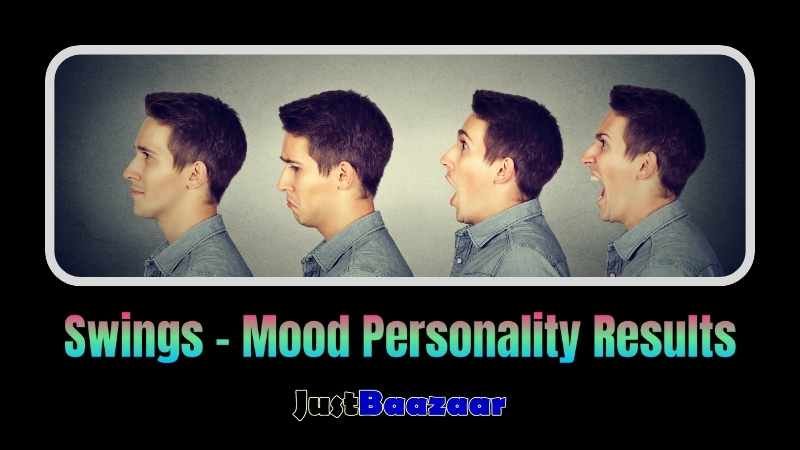Life often resembles a rollercoaster ride, with its ups and downs, twists and turns. In our journey towards our goals, we encounter various swings – from mood swings that affect our emotions, to personality swings that influence our behaviors, and ultimately, to results swings that shape our outcomes. Understanding and managing these swings is key to maintaining balance and achieving success.
Swings – Mood Personality Results

Mood Swing: Riding the Emotional Rollercoaster Emotions are like waves, sometimes gentle and soothing, other times turbulent and overwhelming. Mood swings are a natural part of the human experience, influenced by factors such as stress, hormones, and external events. One moment we may feel on top of the world, and the next, we’re plunged into despair. Learning to recognize and regulate our emotions is essential for maintaining mental well-being and resilience in the face of life’s challenges.
Tips for Managing Mood Swings:
- Practice mindfulness and self-awareness to identify triggers and patterns in your mood fluctuations.
- Develop coping strategies such as deep breathing, meditation, or talking to a trusted friend or therapist.
- Establish healthy lifestyle habits including regular exercise, sufficient sleep, and a balanced diet to support emotional stability.
- Cultivate gratitude and positivity by focusing on the present moment and acknowledging small victories.
Personality Swing: Embracing Flexibility and Adaptability Our personalities are not fixed; they are dynamic and responsive to our experiences and environments. Personality swings refer to changes in our typical behavior, attitudes, and traits in different situations. For example, introverts may become more outgoing in social settings, or normally calm individuals may exhibit assertiveness in high-pressure scenarios. Embracing flexibility and adaptability in our personalities allows us to navigate diverse social interactions and overcome obstacles with greater ease.
Strategies for Embracing Personality Swings:
- Foster a growth mindset that values learning and personal development over rigid adherence to fixed personality traits.
- Practice empathy and perspective-taking to understand others’ viewpoints and adapt your behavior accordingly.
- Step out of your comfort zone regularly to expand your repertoire of behaviors and responses.
- Reflect on past experiences to identify instances where adjusting your personality contributed to positive outcomes.
Results Swing: Turning Setbacks into Opportunities for Growth In the pursuit of our goals, we inevitably encounter setbacks and disappointments. Results swings refer to the fluctuations in our achievements and outcomes over time. While it’s easy to feel discouraged by failure or setbacks, they also present valuable opportunities for learning, growth, and resilience. By reframing setbacks as temporary obstacles rather than insurmountable barriers, we can maintain momentum and strive towards long-term success.
Strategies for Managing Results Swings:
- Cultivate a resilient mindset that views setbacks as learning experiences and opportunities for growth.
- Break down larger goals into smaller, manageable tasks to maintain motivation and momentum.
- Seek feedback from mentors, peers, or experts to gain insights and identify areas for improvement.
- Celebrate progress and achievements, no matter how small, to stay motivated and maintain a positive outlook.
Conclusion: Navigating the swings of mood, personality, and results is an ongoing journey that requires self-awareness, resilience, and adaptability. By understanding the interconnectedness of these swings and implementing strategies to manage them effectively, we can cultivate emotional well-being, interpersonal effectiveness, and achievement in our lives. Remember, it’s not about avoiding the swings altogether, but rather learning to ride them with grace and resilience.
Mood swings can have a significant impact on a person’s overall well-being and daily functioning. Here’s an elaboration with a heading 2 (h2) structure:
Emotional Rollercoaster
Mood swings often subject individuals to an emotional rollercoaster, where they experience abrupt shifts in mood and temperament. This rollercoaster ride can range from intense highs of happiness and euphoria to profound lows of sadness, irritability, or anger. These rapid changes can be disorienting and exhausting, making it challenging for individuals to maintain stability in their emotions and behavior.
Interpersonal Relationships
Mood swings can strain interpersonal relationships. The unpredictability of mood swings may cause confusion, frustration, and stress for friends, family members, and colleagues. Loved ones may find it difficult to understand or cope with the sudden shifts in mood, leading to conflicts and strained interactions. Over time, this can weaken relationships and erode trust, further exacerbating the emotional turmoil experienced by the individual.
Productivity and Functioning
Mood swings can significantly impact a person’s productivity and daily functioning. During periods of heightened mood, individuals may feel energized and motivated, leading to bursts of productivity. However, when mood swings towards negativity, concentration and focus can diminish, making it challenging to complete tasks or meet responsibilities. This fluctuation in productivity can disrupt work or academic performance and hinder personal goals and aspirations.
Mental Health
Frequent or severe mood swings can also take a toll on mental health. For some individuals, mood swings may be symptomatic of underlying mental health conditions such as bipolar disorder, borderline personality disorder, or depression. These conditions can exacerbate mood instability and may require professional intervention and treatment to manage effectively. Additionally, the emotional distress caused by persistent mood swings can contribute to feelings of anxiety, low self-esteem, and hopelessness, further impacting overall mental well-being.
Coping Strategies
Managing mood swings often requires a combination of self-care strategies, therapy, and medication. Individuals may benefit from developing coping mechanisms such as mindfulness, stress management techniques, regular exercise, and maintaining a healthy lifestyle. Additionally, therapy can provide a supportive environment to explore and address underlying emotional issues contributing to mood instability. In some cases, medication prescribed by a healthcare professional may help stabilize mood fluctuations and improve overall quality of life
Bipolar Disorder
Bipolar disorder is a mental health condition characterized by extreme mood swings that include emotional highs (mania or hypomania) and lows (depression). These mood swings can range from periods of elevated mood, increased energy, and impulsivity (mania or hypomania) to episodes of profound sadness, low energy, and feelings of hopelessness (depression). The shifts in mood and energy levels can be disruptive and impair daily functioning, relationships, and overall quality of life.
Manic Episodes
During manic episodes, individuals may experience:
- Elevated mood or irritability
- Increased energy and activity levels
- Racing thoughts and rapid speech
- Impulsivity and risky behavior, such as excessive spending, reckless driving, or substance abuse
- Decreased need for sleep
- Grandiose beliefs about one’s abilities or importance
Depressive Episodes
During depressive episodes, individuals may experience:
- Persistent feelings of sadness, emptiness, or hopelessness
- Loss of interest or pleasure in activities once enjoyed
- Fatigue or loss of energy
- Changes in appetite or weight
- Difficulty concentrating or making decisions
- Thoughts of death or suicide
Types of Bipolar Disorder
There are several types of bipolar disorder, including:
- Bipolar I Disorder: Characterized by manic episodes lasting at least seven days or severe enough to require hospitalization. Depressive episodes may also occur.
- Bipolar II Disorder: Characterized by hypomanic episodes (less severe than full-blown mania) alternating with depressive episodes.
- Cyclothymic Disorder: Characterized by numerous periods of hypomanic symptoms and depressive symptoms lasting for at least two years (one year in children and adolescents).
Treatment
Treatment for bipolar disorder typically involves a combination of medication, psychotherapy, and lifestyle adjustments. Mood stabilizers, antipsychotic medications, and antidepressants may be prescribed to help manage mood swings and stabilize mood. Psychotherapy, such as cognitive-behavioral therapy (CBT) or interpersonal therapy (IPT), can help individuals develop coping skills, improve relationships, and manage stress. Additionally, maintaining a regular sleep schedule, engaging in regular exercise, and avoiding alcohol and recreational drugs can help stabilize mood and reduce the frequency and severity of mood swings.
Strained Communication
Mood swings can strain communication within relationships. Sudden shifts in mood may lead to misinterpretation of intentions or messages, as individuals may struggle to express themselves clearly or react sensitively to perceived slights. This breakdown in communication can create tension, misunderstandings, and conflict, making it challenging for partners, family members, or friends to connect effectively.
Lack of Stability
Mood swings can create instability in relationships. The unpredictability of mood fluctuations may leave loved ones feeling uncertain or on edge, unsure of how to navigate interactions or provide support. This lack of stability can erode trust and security within the relationship, as individuals may feel emotionally unanchored or constantly walking on eggshells to avoid triggering negative reactions.
Emotional Distance
Repeated mood swings can lead to emotional distance between individuals in a relationship. Loved ones may withdraw or disengage emotionally in response to the ongoing volatility, as they may feel overwhelmed, exhausted, or unable to provide the support needed. This emotional distance can create feelings of loneliness, isolation, or abandonment, further exacerbating the strain on the relationship.
Conflict and Resentment
Mood swings often contribute to conflict and resentment within relationships. The intensity and frequency of mood fluctuations can lead to arguments, disagreements, or power struggles as individuals struggle to navigate the emotional turbulence. Over time, unresolved conflicts and lingering resentment may build up, creating a wedge between partners or causing rifts within families or friend groups.
Supportive vs. Enabling Dynamics
Managing mood swings in relationships can also influence the dynamic between individuals. Loved ones may oscillate between offering support and setting boundaries to protect their own well-being. While providing empathy, understanding, and encouragement can be beneficial, enabling destructive behaviors or accepting emotional abuse is harmful. Striking a balance between support and self-care is essential for maintaining healthy boundaries and promoting mutual respect within the relationship.
Seeking Professional Help
Coping with mood swings in relationships often requires open communication, patience, and empathy from both parties. Seeking professional help, such as couples therapy or family counseling, can provide a supportive environment to address underlying issues, improve communication skills, and develop coping strategies together. Additionally, individual therapy or support groups may help individuals with mood swings learn effective techniques for managing emotions and building healthier relationships.
Managing mood swings often involves a combination of lifestyle changes, self-care strategies, therapy, and sometimes medication. Here are some approaches that can be helpful:
Therapy
- Cognitive Behavioral Therapy (CBT): CBT helps individuals identify and challenge negative thought patterns and develop healthier coping mechanisms for managing emotions.
- Interpersonal Therapy (IPT): IPT focuses on improving communication skills and resolving interpersonal conflicts, which can contribute to mood swings.
- Mindfulness-Based Therapies: Practices such as mindfulness meditation and mindfulness-based stress reduction (MBSR) can help individuals cultivate present-moment awareness and reduce reactivity to emotional triggers.
Medication
- Mood Stabilizers: These medications, such as lithium or anticonvulsants, are commonly used to stabilize mood and reduce the frequency and severity of mood swings, particularly in conditions like bipolar disorder.
- Antidepressants: In some cases, antidepressants may be prescribed to alleviate symptoms of depression or anxiety that accompany mood swings. However, they may not be suitable for everyone and can sometimes trigger manic episodes in individuals with bipolar disorder.
Lifestyle Changes
- Regular Exercise: Physical activity can help regulate mood by releasing endorphins, reducing stress, and promoting better sleep.
- Healthy Diet: Eating a balanced diet rich in fruits, vegetables, whole grains, and lean proteins can support overall well-being and stabilize blood sugar levels, which can impact mood.
- Adequate Sleep: Prioritizing quality sleep is crucial for regulating mood. Establishing a consistent sleep schedule and practicing good sleep hygiene can help improve sleep quality.
- Stress Management: Engaging in relaxation techniques such as deep breathing, progressive muscle relaxation, or yoga can help reduce stress levels and promote emotional stability.
Social Support
- Maintaining Relationships: Cultivating supportive relationships with friends, family, or support groups can provide emotional validation, encouragement, and practical assistance during challenging times.
- Setting Boundaries: Establishing boundaries and communicating needs effectively with loved ones can help manage interpersonal stressors and prevent emotional burnout.
Mind-Body Practices
- Journaling: Writing down thoughts and feelings in a journal can provide an outlet for processing emotions and gaining insight into triggers for mood swings.
- Art Therapy: Engaging in creative activities such as painting, drawing, or music can serve as a therapeutic outlet for expressing emotions and promoting relaxation.
It’s essential for individuals experiencing significant mood swings to consult with a healthcare professional for an accurate diagnosis and personalized treatment plan tailored to their specific needs and circumstances.
Mood swings themselves are neither inherently good nor bad; rather, their impact depends on various factors, including their frequency, intensity, duration, and underlying causes, as well as how they affect an individual’s overall well-being and functioning.
Potential Positive Aspects:
- Normal Emotional Fluctuations: Occasional mood swings are a normal part of the human experience and can reflect natural responses to life events, stressors, or hormonal changes.
- Creative Expression: Some individuals may find that mood swings fuel creativity and artistic expression, as intense emotions can inspire music, art, writing, or other forms of self-expression.
- Adaptive Response: Mood swings can sometimes serve as adaptive responses to challenging situations, helping individuals navigate complex emotions and make necessary adjustments to cope with stress or adversity.
Potential Negative Aspects:
- Disruption of Daily Functioning: Excessive or severe mood swings can disrupt daily functioning, impairing work, school, relationships, and other areas of life. They may interfere with concentration, decision-making, and interpersonal interactions.
- Impact on Mental Health: Mood swings can be symptomatic of underlying mental health conditions such as bipolar disorder, borderline personality disorder, or depression. When left unaddressed, these conditions can significantly impair quality of life and lead to emotional distress.
- Strained Relationships: Mood swings can strain interpersonal relationships, causing conflicts, misunderstandings, and emotional distance between individuals. Loved ones may find it challenging to cope with the unpredictability of mood fluctuations, leading to frustration and resentment.
- Risk of Harm: In severe cases, mood swings may pose a risk of self-harm or harm to others, particularly during episodes of intense agitation, impulsivity, or suicidal ideation.
Ultimately, whether mood swings are perceived as positive or negative depends on their context and impact on an individual’s life. Seeking support from healthcare professionals, developing healthy coping strategies, and addressing underlying issues can help individuals manage mood swings effectively and improve overall well-being.
The term “female mood swings” typically refers to fluctuations in mood that occur as a result of hormonal changes associated with the menstrual cycle, pregnancy, or menopause. These mood swings are often considered a normal part of a woman’s reproductive life cycle, although their severity and impact can vary from person to person. Here’s a breakdown of mood swings across different stages of a woman’s life:
Menstrual Cycle
- Premenstrual Syndrome (PMS): Many women experience mood swings in the days leading up to menstruation, known as premenstrual syndrome (PMS). Symptoms can include irritability, moodiness, anxiety, sadness, or fatigue.
- Premenstrual Dysphoric Disorder (PMDD): Some women experience more severe mood symptoms that significantly interfere with daily functioning, a condition known as premenstrual dysphoric disorder (PMDD). PMDD symptoms may include intense mood swings, depression, anger, or tension.
Pregnancy
- First Trimester: Hormonal changes during early pregnancy can contribute to mood swings, along with physical discomfort, fatigue, and emotional adjustments to the pregnancy.
- Second and Third Trimesters: Mood swings may continue throughout pregnancy due to hormonal fluctuations, stress, and concerns about childbirth and parenthood. Some women may experience anxiety or depression during pregnancy, requiring support and monitoring from healthcare providers.
Postpartum Period
- Postpartum Blues: Many women experience mild mood swings and emotional fluctuations in the days and weeks following childbirth, often referred to as the “baby blues.” Symptoms typically resolve on their own within a few weeks.
- Postpartum Depression (PPD): Some women experience more severe and persistent mood symptoms after childbirth, known as postpartum depression (PPD). PPD can include symptoms such as sadness, anxiety, irritability, and difficulty bonding with the baby.
Menopause
- Perimenopause: During the transition to menopause, which can span several years, women may experience hormonal fluctuations that contribute to mood swings, along with other symptoms such as hot flashes, insomnia, and changes in libido.
- Menopause: After menopause, when menstruation has ceased for at least 12 consecutive months, hormonal fluctuations stabilize, and mood swings typically diminish. However, other factors such as stress, lifestyle changes, and underlying health conditions can still influence mood.
While mood swings associated with hormonal changes are common, it’s essential to differentiate between normal fluctuations and more severe mood disturbances that may indicate a mood disorder such as depression or anxiety. Women experiencing significant or persistent mood symptoms should seek evaluation and support from healthcare professionals.













